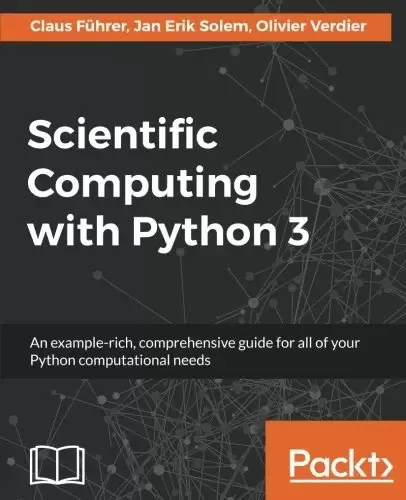
Book Description
Python can be used for more than just general-purpose programming. It is a free, open source language and environment that has tremendous potential for use within the domain of scientific computing. This book presents Python in tight connection with mathematical applications and demonstrates how to use various concepts in Python for computing purposes, including examples with the latest version of Python 3. Python is an effective tool to use when coupling scientific computing and mathematics and this book will teach you how to use it for linear algebra, arrays, plotting, iterating, functions, polynomials, and much more.
What You Will Learn
- The principal syntactical elements of Python
- The most important and basic types in Python
- The essential building blocks of computational mathematics, linear algebra, and related Python objects
- Plot in Python using matplotlib to create high quality figures and graphics to draw and visualize your results
- Define and use functions and learn to treat them as objects
- How and when to correctly apply object-oriented programming for scientific computing in Python
- Handle exceptions, which are an important part of writing reliable and usable code
- Two aspects of testing for scientific programming: Manual and Automatic
Authors
Claus Führer
Claus Führer is a professor of scientific computations at Lund University, Sweden. He has an extensive teaching record that includes intensive programming courses in numerical analysis and engineering mathematics across various levels in many different countries and teaching environments. Claus also develops numerical software in research collaboration with industry and received Lund University’s Faculty of Engineering Best Teacher Award in 2016.
Jan Erik Solem
Jan Erik Solem is a Python enthusiast, former associate professor, and currently the CEO of Mapillary, a street imagery computer vision company. He has previously worked as a face recognition expert, founder and CTO of Polar Rose, and computer vision team leader at Apple. Jan is a World Economic Forum technology pioneer and won the Best Nordic Thesis Award 2005-2006 for his dissertation on image analysis and pattern recognition. He is also the author of “Programming Computer Vision with Python” (O’Reilly 2012).
Table of Contents
Chapter 1. Getting Started
Chapter 2. Variables and Basic Types
Chapter 3. Container Types
Chapter 4. Linear Algebra – Arrays
Chapter 5. Advanced Array Concepts
Chapter 6. Plotting
Chapter 7. Functions
Chapter 8. Classes
Chapter 9. Iterating
Chapter 10. Error Handling
Chapter 11. Namespaces, Scopes, and Modules
Chapter 12. Input and Output
Chapter 13. Testing
Chapter 14. Comprehensive Examples
Chapter 15. Symbolic Computations – SymPy
中文:
书名:使用Python3进行科学计算,第2版
除了通用编程之外,Python还可以用于更多用途。它是一种自由、开放源码的语言和环境,在科学计算领域具有巨大的使用潜力。本书介绍了与数学应用程序紧密相关的Python,并演示了如何使用Python中的各种概念进行计算,包括最新版本的Python3的示例。当将科学计算和数学结合在一起时,Python是一个有效的工具,本书将教您如何将其用于线性代数、数组、绘图、迭代、函数、多项式等。
你将学到什么
- The principal syntactical elements of Python
- The most important and basic types in Python
- 计算数学、线性代数和相关的Python对象的基本构建块
- 使用matplotlib在Python中绘制图形,以创建高质量的图形和图形来绘制和可视化结果
- 定义和使用函数,并学会将其视为对象
- 如何以及何时正确地将面向对象编程应用于在Python中进行科学计算
- 处理异常,这是编写可靠和可用的代码的重要部分
- 科学编程测试的两个方面:手动和自动
作者
克劳斯·富勒
克劳斯·富勒是瑞典隆德大学的科学计算教授。他有广泛的教学记录,包括在许多不同国家和教学环境的不同水平的数值分析和工程数学的密集编程课程。克劳斯还与工业界合作研究开发数值软件,并在2016年获得隆德大学工程系最佳教师奖。
Jan Erik Solem
简·埃里克·索勒姆是一名巨蟒爱好者,曾任副教授,目前是街道图像计算机视觉公司Mapillary的首席执行官。他之前曾担任过人脸识别专家、Polar Rose的创始人兼CTO,以及苹果的计算机视觉团队负责人。Jan是世界经济论坛的技术先驱,因其关于图像分析和模式识别的论文而获得2005-2006年度最佳北欧论文奖。他也是《用Python编程计算机视觉》(O’;Reilly 2012)一书的作者。
目录表
第1章:入门
第二章变量和基本类型
第三章.集装箱类型
第四章.线性代数–阵列
第5章:高级阵列概念
第六章.策划
第七章.职能
第八章.班级
第9章.迭代
第10章.错误处理
第11章.命名空间、作用域和模块
Chapter 12. Input and Output
第十三章.测试
第十四章.全面的例子
Chapter 15. Symbolic Computations – SymPy
评论前必须登录!
注册